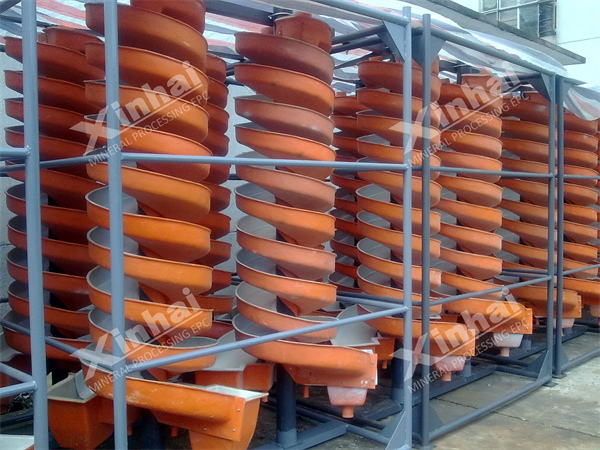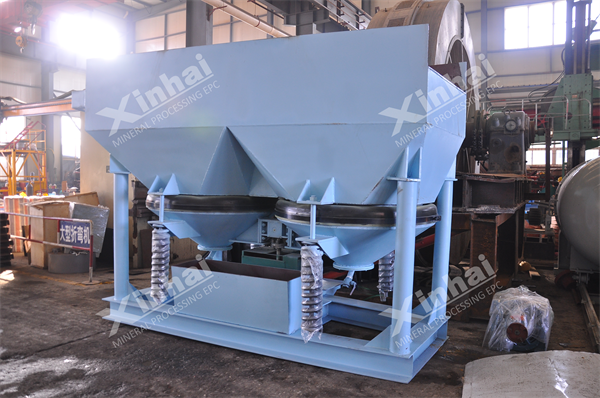Gravity separation is a widely used method in the mineral processing industry to separate minerals based on their density and particle size. It relies on the gravitational force exerted on particles to achieve separation. In this article, we will delve into three commonly used gravity separation equipment: the Spiral Chute, Concentrating Table, and Jig, discussing their working principles, applications, advantages, and case.

Working Principle
The Spiral Chute utilizes the centrifugal force generated by the spiral motion of the slurry within the chute to separate lighter particles from heavier ones. As the slurry flows down the spiral trough, denser particles settle to the bottom due to gravity, while lighter particles are carried upward by the spiral motion and discharged at the top.
Applications
Spiral Chutes are commonly used for the separation of fine-grained materials with low density, such as placer gold, tungsten, tin, tantalum, niobium, and chromite. They are particularly effective for the concentration of beach sand minerals and alluvial deposits.
Advantages
- Simple structure and easy operation
- High separation efficiency for fine particles
- Suitable for a wide range of particle sizes and densities
- Low operating cost and maintenance requirements
Case
A mining operation in Australia utilizes Spiral Chutes to recover fine gold particles from beach sand deposits. The Spiral Chutes effectively separate the gold from other minerals, achieving high recovery rates and ensuring economical gold production.

Working Principle
Similar to the Concentrating Table, the Shaking Table employs shaking motion to create a stratified bed of particles. Heavy particles settle to the bottom while light particles are carried across the deck and discharged.
Applications
Suitable for the concentration of various heavy minerals, including gold, tin, tungsten, and tantalum, particularly effective for recovering fine gold from sulfide ores.
Advantages
Adjustable shaking intensity and inclination, high recovery rates, and low operating costs.
Case
A gold mine in South Africa employs Shaking Tables to recover gold from sulfide ores with complex mineralogy. The tables effectively separate gold-bearing sulfides from gangue minerals, resulting in high-grade gold concentrates suitable for further processing.

Working Principle
The Jig utilizes pulsating water flow and differential settling to separate minerals based on their density and particle size. The jigging action causes denser particles to settle to the bottom of the jig bed, while lighter particles are carried away by the upward flow of water. The jig bed is typically equipped with a screen or bed layer to assist in stratification and separation.
Applications
Jigs are commonly used for the recovery of heavy minerals, including gold, diamonds, tin, tungsten, and coal. They are particularly effective for processing coarse-grained materials and are widely used in placer mining operations and alluvial deposits.
Advantages
- High recovery rates for coarse and medium-sized particles
- Suitable for processing large volumes of material
- Robust and durable construction for long-term operation
- Flexibility in adjusting operating parameters for optimal performance
A diamond mining operation in Botswana utilizes Jigs to recover diamonds from gravel deposits. The Jigs effectively separate diamonds from other heavy minerals, providing high-grade diamond concentrates for further processing and diamond recovery.
Working Principle
Utilizes centrifugal force to separate particles based on their density. The high-speed rotation of the centrifuge creates a radial force field, causing denser particles to migrate outward and settle in the concentrate zone.
Applications
Widely used for the recovery of fine gold, platinum, silver, and other heavy minerals from alluvial and hard rock deposits.
Advantages
High recovery efficiency for fine particles, compact design, and simple operation.
Working Principle
Utilizes hydraulic forces to separate particles based on their settling velocity in a fluid medium. The classifier consists of a series of inclined channels or pipes through which the slurry flows, allowing heavier particles to settle faster than lighter particles.
Applications
Used for the classification and concentration of particles with different densities, commonly employed in coal and mineral processing industries.
Advantages
Efficient separation of particles based on settling velocity, minimal moving parts, and low maintenance requirements.
Working Principle
Relies on centrifugal force to separate particles based on their size and density. The slurry is fed tangentially into the cyclone, creating a vortex motion that causes heavier particles to migrate to the outer wall and exit through the underflow, while lighter particles are carried upward and discharged through the overflow.
Applications
Widely used for the classification and concentration of fine particles in mineral processing circuits, as well as in the coal and chemical industries.
Advantages
High separation efficiency, compact design, and ability to handle high-flow rates.
These gravity separation equipment play a crucial role in mineral processing operations worldwide. Their ability to efficiently separate minerals based on density and particle size makes them indispensable tools for the extraction and concentration of valuable minerals. By understanding their working principles, applications, advantages, and real-world examples, mining operators can make informed decisions to optimize their gravity separation processes and maximize mineral recovery.